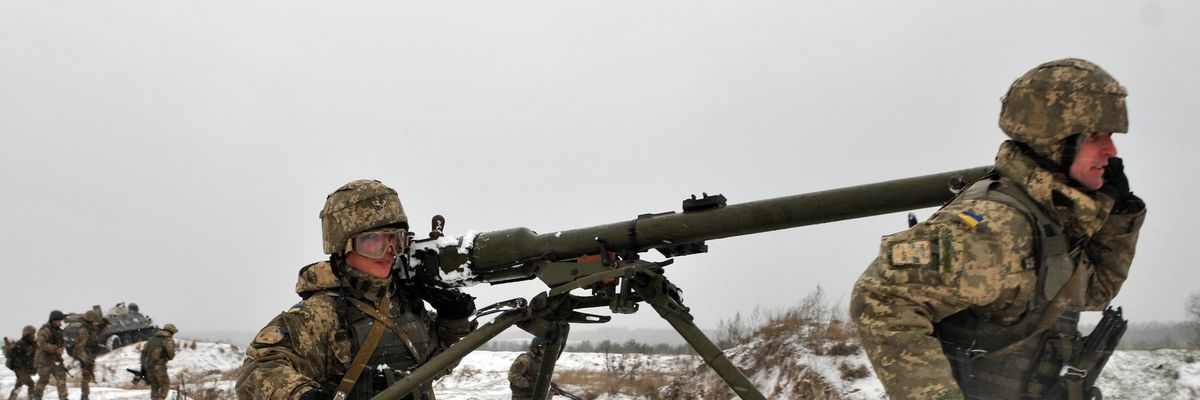Following talks between the U.S. and Russia this month, the landscape looks bleaker than ever in regards to avoiding a clash with Russia over Ukraine. While President Biden has promised a "swift, severe and united" response to any Russian incursion into Ukrainian territory, administration officials are now publicly declaring they are "united for Ukraine" on social media.
A New York Times article late Sunday reports that the Pentagon has handed Biden several options that would shift American military assets much closer to Mr. Putin’s doorstep, including troops and warships and other military assets to allied countries in the region.
Responsible Statecraft asked a host of military and international relations scholars and journalists, as well as former military and intelligence officers, what it would look like if the United States decided to intervene to defend Ukraine. We asked them to answer the following prompt:
"Many in Washington, including media pundits, are saying the U.S. may have to get involved militarily— directly or indirectly — to defend Ukraine should Russia invade. Yet they do not expand on what that would actually mean in practice, or in costs. Based on your experience and expertise, if Washington decides to defend Ukraine against a Russian invasion, what kind of costs and repercussions would such a conflict incur (long and short-term), for the United States and for the region?"
Respondents:
Emma Ashford
Lyle Goldstein
William Hartung
Michael Kimmage
Anatol Lieven
Doug Macgregor
Rajan Menon
Robert W. Merry
Lindsey O'Rourke
Paul Pillar
Monica Duffy Toft
Katrina vanden Heuvel
Stephen Wertheim
***
The United States isn’t going to get directly involved in defending Ukraine from a potential Russian invasion; there will be no troops on the ground, and no direct U.S. military support. But there are a variety of other proposals out there that would dial up lethal arms sales to Ukraine, initiate large-scale NATO exercises elsewhere in Europe, or even help to shelter Ukrainian military assets from Russian attack. Some further arms sales might well be warranted in the event of a large-scale invasion, but the Biden administration should be cautious about taking any of these other steps towards militarizing or deepening U.S. or broader NATO involvement in this conflict. The risks of escalation are simply too high, and Ukraine’s direct importance to U.S. foreign policy too small.
Lyle Goldstein, Director of Asia Engagement at Defense Priorities
U.S. military intervention, whether direct or indirect, in a Russia-Ukraine war would have deleterious and even catastrophic consequences. An indirect U.S. military role, such as offering weapons and military trainers, may sound appealing. Yet, such activities would further cement the “New Cold War,” might prolong the war and the killing, would strain the NATO alliance, and could encourage Russian horizontal escalation, whether in Syria or even Venezuela.
Direct military intervention would carry with it risks of an even higher magnitude. U.S. forces in the region, too small to make a meaningful difference, are likely to become casualties. For example, U.S. Navy units operating in the Black Sea would be isolated and highly vulnerable targets for Russian forces. Moscow could quite conceivably view a wider Ukraine War as an opportunity to severely maul and thus punish NATO members, such as Poland, Romania, or the Baltic states for their perceived transgressions. The economic costs of a wider European war could also be massive, but the most tragic possible outcomes would be the spread of major war to the Asia-Pacific, as well as a limited nuclear exchange — a definite possibility if high intensity combat ensues between Moscow and Washington in Ukraine.
William Hartung, senior research fellow of the Quincy Institute
No one in their right mind is suggesting that the U.S. intervene directly if Russia invades Ukraine. But even indirect intervention could cost billions, while increasing the risks of escalation in ways that could put U.S. personnel – and U.S. interests – in danger.
The U.S. has supplied Ukraine with $2.7 billion in military aid since 2014. Now the Biden administration has stepped up supplies of anti-tank missiles and other military gear to Kyiv and given the green light to Latvia, Estonia, and Lithuania to transfer U.S.-supplied Javelin anti-tank missiles and Stinger anti-aircraft missiles to the Ukrainian military. The U.S. will no doubt pay to replace these missiles, and before you can blink an eye the hundreds of millions of additional U.S. military aid offered in the past few weeks will jump into the billions. The Baltic states and Poland are lobbying for a permanent U.S. troop presence in their countries, which could entail further costs.
Perhaps the biggest risk is posed by the likely deployment of additional U.S. troops and contractors to help to train Ukrainian forces on using U.S.-origin systems. If any U.S. personnel end up on the front lines and are killed in the event of a Russian invasion, the stakes – and the prospects for escalation – will rise dramatically.
In the event of a Russian invasion, Washington could choose to support Ukraine symbolically via the provision of arms and training either of a conventional military kind or of an insurgency. This approach need not incur great costs for the United States and would run little risk of involving the United States directly in the conflict. If, on the other hand, the United States would choose to defend Ukraine from a Russian invasion, this would be a crossing of a Rubicon. It would require the provision of air power, and it would require a substantial commitment of U.S. forces to a country that is territorially large and has a population of some 40 million people. This would incur two separate costs for Washington. One would be financial and military: the expense necessary to enable this involvement and the deployment of military resources to Eastern Europe (rather than to other theaters). The other cost would involve the danger of escalation. There is no doubt that American soldiers and air power on the front lines of a war between Ukraine and Russia would radicalize Russia’s own war aims, contributing to an escalating commitment, and it is hard to imagine that this development would not furnish the impetus to even greater U.S. involvement, a substantial short-term and long-term sequences of costs.
If Russia does invade Ukraine, Russia will win. The Biden administration has ruled out sending troops; and with only four brigades in Europe, the United States is in any case in no position to defend Ukraine, and as for NATO’s European allies, the idea that they will fight Russia in Ukraine is ludicrous.
A Russian invasion would be followed by a new offer of an agreement with the Ukrainian government and the West; most probably a ban on Ukraine joining NATO (or a treaty of neutrality, plus a federal system for Ukraine with autonomy for Russian-speaking areas.
Washington would then have three options:
One would be to send the greater part of the American armed forces to Ukraine to launch a counter-offensive to drive Russia from Ukraine. This would involve tens of thousands of American dead, the risk of nuclear annihilation, and an open invitation to China to establish its hegemony in the Far East.
The second (as threatened) would be to launch a guerrilla war against Russia on the model of the Afghan war of the 1980s. This would lead to permanent conflict in Europe and the likelihood of repeated Russian attacks on Poland.
The third option would be to negotiate a compromise. Or of course we could do that now, and prevent Russia from invading in the first place.
(Ret) Col. Douglas Macgregor, former senior advisor to the Acting Secretary of Defense
The talks between Secretary of State Blinken and Foreign Minister Sergei Lavrov drag on without result. Meanwhile, the Russian military buildup continues without interruption. All of the NATO militaries including United States Forces are turning out to be 'too late to change the outcome’. It seems that all NATO can do is sit and watch Russia intervene at will in eastern and southern Ukraine.
Having failed for at least 20 years to acknowledge Moscow’s legitimate security interests in Ukraine, Washington and its allies will inevitably confront new facts on the ground. The real question for Washington is whether it wishes to live in a state of perpetual conflict or crisis with Moscow?
If Washington declines to recognize that Moscow’s interests in the region outweigh its own, Washington may watch as its allies in Europe gradually fade away. Germany, arguably, the cornerstone in NATO’s edifice, is already signaling its readiness to pursue a new policy path toward Moscow that diverges sharply from Washington’s. How many others will follow the German path before NATO ceases to have any real meaning?
The United States won’t fight Russia to protect Ukraine: President Biden has effectively said that. Ukraine has no illusions that American soldiers will be dispatched to die to save it, possibly triggering a full-on war with Russia that ends in a nuclear confrontation.
Nevertheless, a former DoD official wants the U.S. to muster “an international coalition of the willing” — not just to defend Ukraine were Russia to attack now, but to expel it from Crimea and the Donbas. This idea combines silliness (which states would volunteer for a “coalition” of suicide?) with recklessness (imagine the catastrophe that would result from fighting Russia, on its doorstep no less). But The U.S. and Britain have been arming Ukraine. American soldiers have trained their Ukrainian counterparts since 2015, in Yavoriv, near Lviv, in western Ukraine. Canada has also provided training, since 2020.
Ukraine certainly has the right to acquire the means for self-defense. Yet the cold reality is that what Ukraine has received simply will not suffice to thwart a Russian combined-arms campaign: artillery and air strikes and air assault operations that pave the way for tank and motor-rifle units. Let us hope that diplomacy averts war.
For Russia, Ukraine represents a strategic imperative of the highest order; for America it is an ideological conceit based on a false and dangerous doctrine of American purity in a world of mostly bad guys. With such a differential in strategic significance and in attentiveness to geopolitical reality, an American military response to a Russian invasion of Ukraine can only bring negative outcomes for America and the West: for Europe, chaos, division, and destabilization; for Ukraine, far greater punishment than otherwise would emerge; from China, ever greater provocations aimed at America’s Asian dominance; for Russia, a quantum increase in geopolitical relevance globally and dominance regionally; and for America, a humiliation that will expose further the already discernible diminution in its ability to determine the course of world events.
George W. Bush and Barack Obama, with their reckless and arrogant actions in the Middle East, destroyed for decades any prospect for stability in that unhappy land. America ended up looking like a muscle-bound oaf. But American actions in Europe to counter Russia’s response to NATO’s 25-year encirclement provocation, would perpetuate much the same outcome in the very cradle of Western Civilization. The consequence could very well be catastrophic.
If Russia invades Ukraine, many in Washington are likely to see covertly arming anti-Russian forces within Russian-occupied territories as an attractive middle option between full-blown war and doing nothing in response. Unfortunately, as I show in my book Covert Regime Change, America’s track record for covertly arming foreign dissidents is quite poor. During the Cold War, for instance, only 4 out of America’s 35 operations to covertly arm foreign dissidents during U.S.-backed covert regime change attempts succeeded in bringing America’s insurgent allies to power. Instead, such operations typically succeeded only in raising the cost of the conflict for all parties involved, prolonging bloody civil wars, and increasing civilian suffering. Furthermore, if Russia does invade Ukraine, Moscow is likely to limit its invasion to more sympathetic regions within Eastern Ukraine. This, in turn, would limit America’s ability to covertly organize an effective partisan defense. Even if an anti-Russian opposition emerged, Russia would still enjoy escalation dominance in the region, suggesting a low long-term prospect for success.
In any military involvement in Ukraine, the United States would suffer from severe asymmetries in both will and capability. Ukraine always will be much more important to Russia than it is to the United States. As for capabilities, the massing of Russian forces along the Ukrainian border is a reminder of a huge Russian advantage in geography and lines of communication. War in Ukraine would be a losing proposition for the United States from the firing of the first shots.
Ukrainian forces—and a Ukrainian insurgency, if it came to that—would be able to keep Russia from swallowing Ukraine smoothly. But Putin’s regime is far too committed on the issues involved to back off or back out simply because the conflict would become costly for Russia as well. A short-term quagmire could easily become a long-term one for everyone involved.
The resulting drain on U.S. resources, policymaking bandwidth, and willingness to make good on other commitments would have far-reaching repercussions. Intra-European disagreements on dealing with Russia would intensify. Great power cooperation on other issues would suffer. Those seeing an opportunity to benefit from U.S. distraction (think of China vis-à-vis Taiwan) would be tempted to act.
Monica Duffy Toft, professor of international politics and director of the Center for Strategic Studies at The Fletcher School of Tufts University
Direct and indirect aid to Ukraine and short- and long-term repercussions to the United States are key distinctions. Direct aid would include U.S. armed forces. The United States is unlikely to do this without a UN resolution, which won't happen because Russia would veto it. Militarily, NATO would have to be unified, but NATO is divided because Russia holds Europe's economies hostage to Russia's energy resources. Indirect aid is already arriving in the form of anti-tank weapons, other defensive hardware, and cyber support. If Russia attacks, U.S. indirect support won’t prevent a Russian win. Short-term a failed indirect defense for the United States would be costly in terms of its capacity to deter aggression. Its reputation was already damaged by Syria's violation of President Barak Obama’s “red line” in 2013, and the tepid international response to Russia’s armed annexation of the Crimea in 2014.
Moreover, sanctions sufficient to deter or punish Russia would be difficult to enforce because again, Russia dominates Europe’s access to energy (it is no accident this is happening in winter). Long-term, a failed U.S. indirect defense of Ukraine may prove catastrophic: if Ukraine is this century’s Sudetenland, allowing Russia to establish that its interests supersede the sovereignty and independence of internationally recognized states on its periphery, may again lead to a world war that no one can win.
Any intervention now would squander U.S. attention and resources on challenges posed by the pandemic, economic inequality, racial divisions and catastrophic climate change. What is essentially a civil war will become more entrenched as a proxy war — with grave geopolitical repercussions, mass displacement, empowering China, dividing European allies, fueling already challenging nuclear insecurity — and, if U.S. troops are there training Ukrainians, we may see American casualties. That could lead to even more U.S. involvement and a potential and exceedingly dangerous quagmire.
The United States just exited from the longest war in American history (Korean War excluded). Brown University’s Costs of War project estimates the Afghan war cost $5.8 trillion; the international community now appears unable to provide even $5 billion in humanitarian assistance. Scores of U.S. drone attacks misfired, killing thousands of innocent civilians. May this remind us of the true costs and repercussions of military misadventures: accountability is rarely demanded, and such military debacles undermine an already fragile democracy at home.
Ukraine demands a diplomatic and political resolution. A positive outcome would be the expansion of a new and demilitarized international security architecture in the region, and a moratorium on NATO expansion, along with international guarantees for Ukraine’s independence. May it be a bridge between East and West.
Several politicians and commentators warn that a Russian invasion of Ukraine would upend peace and stability globally. In particular, they suggest, a display of American weakness might entice China to invade Taiwan.
This argument could potentially resonate with Americans who would otherwise oppose serious military involvement in Ukraine against a great power and nuclear peer. But it is mistaken and gets the risks backward.
If the United States declined to go to war over Ukraine, a country it has no formal obligation to defend, this should hardly surprise Chinese leaders or change their decisions toward Taiwan. Invading Taiwan remains a huge strategic gamble, not to mention a personal one for President Xi Jinping as he seeks a third term this fall.
If, however, the U.S were to sleepwalk into war with Russia, it would then have to divert enormous resources to Europe. Deterrence in Asia would weaken. Moreover, Chinese leaders would see the United States breaching its own longstanding limits by defending Ukraine. They could fear that Taiwan might be next — that America would actually treat the island as part of its defense perimeter, even though Washington has no clear commitment to defend Taiwan and officially supports its peaceful reunification with the mainland. China might decide to strike, thinking it is now or never.
This fanciful scenario ought to remain just that. Biden has taken the use of force in Ukraine off the table. A Chinese invasion of Taiwan remains unlikely. But it’s important to remember, as passions rise, why war with Russia would be the worst course of action possible.
















